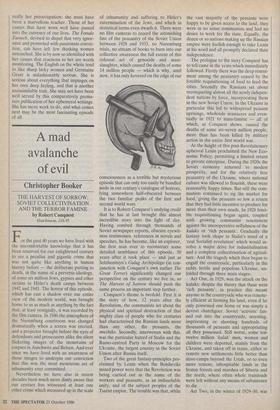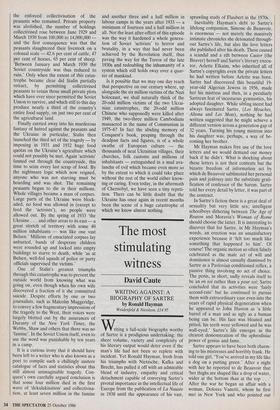A mad avalanche of evil
Christopher Booker
THE HARVEST OF SORROW: SOVIET COLLECTIVISATION AND THE TERROR FAMINE by Robert Conquest
Hutchinson, £16.95
For the past 40 years we have lived with the uncomfortable knowledge that it has been reserved for our enlightened century to see a peculiar and gigantic crime that was not •quite like anything in human history before — the deliberate putting to death, in the name of a perverse ideology, of some six million Jews, gypsies and other victims in Hitler's death camps between 1942 and 1945. The horror of this episode, which has cast a shadow over our entire view of the modern world, was brought home to us as much as anything by the fact that, at least vestigially, it was recorded by the film camera. In 1946 the atmosphere of the Nuremburg courtroom was changed dramatically when a screen was erected, and a projector brought before the eyes of defendants and prosecutors alike the silent flickering images of the mountains of corpses in Auschwitz and Belsen. And ever since we have lived with an awareness of those images to underpin our conviction that this was the most monstrous act of inhumanity ever committed.
Nevertheless we have also in recent decades been much more dimly aware that our century has witnessed at least one other crime which measured up in the scale of inhumanity and suffering to Hitler's extermination of the Jews, and which in statistical terms even dwarfs it. There were no film cameras to record the astonishing fate of the peasantry of the Soviet Union between 1929 and 1933, no Nuremburg trials, no stream of books to burn into our collective awareness the full extent of this colossal act of genocide and mass- slaughter, which caused the deaths of some 14 million people — which is why, until now, it has only hovered on the edge of our consciousness as a terrible but mysterious episode that can only too easily be bundled aside in our century's catalogue of horrors, lying somewhere half-obscured between the two familiar peaks of the first and second world wars. • It is to Robert Conquest's undying credit that he has at last brought this almost incredible story into the light of day. Having combed through thousands of Soviet newspaper reports, obscure eyewit- ness testimonies, references in novels and speeches, he has become, like an explorer, the first man ever to reconstruct some detailed semblance of this episode, 50 years after it took place — and just as Solzhenitsyn's Gulag Archipelago (in con- junction with Conquest's own earlier The Great Terror) significantly changed our perspective on the century we live in, so The Harvest of Sorrow should push the same process an important step further.
Conquest's theme is twofold. First it is the story of how, 12 years after the Revolution, the communists set about the physical and spiritual destruction of that mighty class of people who for centuries had characterised the Russian lands more than any other, the peasants, the muzhiks. Secondly, interwoven with this, was the particular hatred of Stalin and the Russo-centred Party in Moscow for the Ukraine, the largest country in the Soviet Union after Russia itself.
Two of the great fantasy-principles pro- claimed by Lenin when the Bolsheviks seized power were that the Revolution was being carried out in the name of the workers and peasants, as an indissoluble unity, and of the subject peoples of the Tsarist empire. The trouble was that, while the vast majority of the peasants were happy to be given access to the land, they were in no sense communists and had no desire to work for the state. Equally, the dozen or so nations making up the Russian empire were foolish enough to take Lenin at his word and all promptly declared their independence.
The prologue to the story Conquest has to tell came in the years which immediately followed. Firstly there was the deep resent- ment among the peasantry caused by the forcible requisitioning of food to feed the cities. Secondly the Russians set about reconquering almost all the newly indepen- dent nations by force, incorporating them in the new Soviet Union. In the Ukraine in particular this led to widespread peasant uprisings, wholesale massacres and even- tually in 1921 to mass-famine — all of which, as Conquest shows, caused the deaths of some six–seven million people, more than has been killed by military action in the entire first world war.
At the height of this post-Revolutionary upheaval Lenin proclaimed the New Eco- nomic Policy, permitting a limited return to private enterprise. During the 1920s the Soviet economy returned to modest prosperity, and for the relatively free peasantry of the Ukraine, where national culture was allowed to flourish, these were reasonably happy times. But still the com- munists continued to rig the market for food,'giving the peasants so low a return that they had little incentive to produce for more than their own needs. In 1928 forci- ble requisitioning began again, coupled with growing communist resentment against the uncooperative selfishness of the kulaks or 'rich peasants'. Gradually the fantasy took shape in Stalin's mind of a 'real Socialist revolution' which would in- volve a major drive for industrialisation and a complete collectivisation of agricul- ture. And the tragedy which then began to engulf the countryside, particularly in the richly fertile and populous Ukraine, un- folded through three main stages.
Act One, in 1929, was the attack on the kulaks: despite the theory that these were 'rich peasants', in practice this meant anyone in the countryside who was remote- ly efficient at farming his land, even if he only possessed one horse or was simply a devout churchgoer. Soviet 'activists' fan- ned out into the countryside, arresting, imprisoning or shooting hundreds of thousands of peasants and appropriating all they possessed. Still worse, some ten- twelve million `kulak' men, women and children were deported, mainly from the Ukraine, and taken off in trains, either to remote new settlements little better than slave-camps beyond the Urals, or to even more remote, inhospitable lands in the frozen forests and marshes of Siberia and the north, where often whole trainloads were left without any means of subsistence to die.
Act Two, in the winter of 1929-30, was the enforced collectivisation of the peasants who remained. Private property was abolished, the number of holdings collectivised rose between June 1929 and March 1930 from 100,000 to 14,000,000 — and the first consequence was that the peasants slaughtered their livestock on a colossal scale — 42.6 per cent of cattle, 47 per cent of horses, 65 per cent of sheep. 'Between January and March 1930 the Soviet countryside was thus reduced to ruin.' Only when the extent of this catas- trophe became clear did Stalin partially retract, by permitting collectivised peasants to retain those small private plots which have ever since permitted the Soviet Union to survive, and which still to this day produce nearly a third of the country's entire food supply, on just two per cent of the agricultural land.
Finally carried away into his murderous fantasy of hatred against the peasants and the Ukraine in particular, Stalin then launched the third act of the tragedy — by imposing in. 1931 and 1932 huge food quotas on the Ukraine's agriculture which could not possibly be met. Again 'activists' fanned out through the countryside, this time to seize every last scrap of food. By the nightmare logic which now reigned, anyone who was not starving must be hoarding and was shot. The remaining peasants began to die in their millions. Whole villages became a mass of corpses. Large parts of the Ukraine were block- aded, no food was allowed in (except to feed the `activists'), no people were allowed out. BS/ the spring of 1933 'the Ukraine. . . and other areas to its east — a great stretch of territory with some 40 million inhabitants — was like one vast Belsen.' Millions of emaciated corpses lay unburied, bands of desperate children were rounded up and locked into empty buildings to starve to death, while `as at Belsen, well-fed squads of police or party officials supervised the victims.'
One of Stalin's greatest triumphs through this catastrophe was to prevent the outside world from knowing what was going on, even though when his own wife discovered a fraction of it she committed suicide. Despite efforts by one or two journalists, such as Malcolm Muggeridge, to convey a few fragmentary impressions of the tragedy to the West, their voices were largely blotted out by the assurances of Duranty of the New York Times, the Webbs, Shaw and others that there was no `famine'. In the Soviet Union itself, even to use the word was punishable by ten years in a camp.
It is a curious irony that it should have been left to a writer who is also known as a poet to compile such a chillingly austere catalogue of facts and statistics about this still almost unimaginable tragedy. Con- quest's own carefully argued conclusion is that some four million died in the first wave of `dekulakisation' and collectivisa- tion, at least seven million in the famine and another three and a half million in labour camps in the years after 1933 — a minimum of fourteen and a half million in all. Not the least after-effect of this episode was the way it hardened a whole genera- tion of Soviet 'activists' to horror and brutality, in a way that had never been achieved by the Revolution itself, thus paving the way for the Terror of the late 1930s and redoubling the inhumanity of a system which still holds sway over a quar- ter of mankind.
Is it possible that we may one day reach that perspective on our century where, up alongside the six million victims of the Nazi holocaust, we shall naturally think of the 20-odd million victims of the two Ukrai- nian catastrophes, the 20-odd million Chinese who supposedly were killed after 1949, the two-three million Cambodians massacred in the name of Communism in 1975-6? In fact the abiding memory of Conquest's book, peeping through the deadpan facts and figures, is of a whole swathe of European culture — the thousands of neat Ukrainian villages, their churches, folk customs and millions of inhabitants — extinguished in a mad ava- lanche of evil which became even more so by the extent to which it could take place without the rest of the world either know- ing or caring. Even today, in the aftermath of Chernobyl, we have seen a tiny repeti- tion. There can be little doubt that the Ukraine has once again in recent months been the scene of a huge catastrophe of which we know almost nothing.



























































 Previous page
Previous page